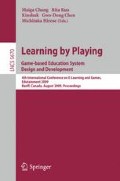Abstract
A interactive storytelling based service has been developed for the learning project Atlantis University. It provides methods for presenting user adaptive non-linear coherent content in the context of Extended Blended Learning. Like other non-linear projects, it has the problem that huge amount of content is needed.
First the Atlantis University Project including the most significant methods used are presented briefly. Then an approach to overcome the problem by merging learner-types, a storytelling based coherence service and a content contribution system is presented.
Access this chapter
Tax calculation will be finalised at checkout
Purchases are for personal use only
Preview
Unable to display preview. Download preview PDF.
References
Bleimann, U., Röll, F.J.: Extended Blended Learning – Innovative Lernszenarien für die Hochschule. In: Querschnitt (Beiträge aus Forschung und Entwicklung der FH Darmstadt, Darmstadt, Germany, vol. 01/06 (2006)
Bleimann, U.: Atlantis University – A New Pedagogical Approach beyond E-Learning. Campus-Wide Information Systems 21(5), 191–195 (2004)
Schneider, O., Bleimann, U., Phippen, A.D., Harriehausen-Mühlbauer, B.: Inside Coherence: Concept for a Non-Linear eLearning Solution. In: Proceedings of the Seventh International Network Conference (INC 2008), Plymouth, UK, Network Research Group, University of Plymouth (July 2008)
Bruffee, K.A.: Collaborative Learning: Higher Education, Interdependence, and the Authority of Knowledge. Johns Hopkins University Press, Baltimore (1999)
Batatia, H., Ayache, A., Markkanen, H.: Netpro: An Innovative Approach to Network Project Based Learning. In: Proceedings of the International Conference on Computers in Education (ICCE 2002), Auckland, New Zealand, College of Business, Massey University, pp. 382–386. IEEE Computer Society, Los Alamitos (2002)
Neo, M.: Web-Enhanced Learning: Engaging Students in Constructivist Learning. Campus-Wide Information Systems 22(1), 4–14 (2005)
Mills, J.E., Treagust, D.F.: Engineering Education – is Problem-Based or Project-Based Learning the Answer? In: Scott, N., Hadgraft, R., Ilic, V.V. (eds.) Australasian Journal of Engineering Education, The Australasian Association for Engineering Education Inc. (2003) ISSN 1324-5821, http://www.aaee.com.au/journal/2003/mills_treagust03.pdf (accessed 23rd January 2009)
Brückner, S.: Structure Patterns Depending on Various Learner Types in an e-learning Context. Diploma thesis, Fachhochschule Darmstadt (2005)
Röll, F.J.: Computermedien, Bildungsmedien. Vom pädagogischen Nadelöhr zur selbstbestimmten Bildung. In: Schindler, W. (ed.) MaC*_Reloaded: Perspektiven aus der Skepsis für *Menschen am Computer. RabenStück Verlag für Kinder- und Jugendhilfe, Chemnitz, Germany, pp. 37–58 (2005) ISBN 3-935607-22-9
Röll, F.J.: Entdecken Sie Ihren persönlichen Lernstil (April 2006), http://comas.offeneslernen.de/lerno/MPX_rubrik.php?rubrik_id=289 (accessed January 30, 2009)
Currin, L.: Feelin’ Groovy (2004), http://www.elearnmag.org/subpage.cfm?section=articles&article=10-1 (accessed February 6, 2009)
Spitzer, M.: Lernen. Gehirn-Forschung und die Schule des Lebens. Elsevier, Spektrum, Akademischer Verlag, München (2002)
Gagné, R.M., Briggs, L.J., Wager, W.W.: Principles of Instructional Design. Harcourt Brace Jovanovich College, Fort Worth (1992)
Schell, J.: Understanding Entertainment: Story And Gameplay Are One. In: Jacko, J.A., Sears, A. (eds.) The Human-Computer Interaction Handbook: Fundamentals, Evolving Technologies and Emerging Applications. Lawrence Erlbaum Associates, Florence (2002)
Schneider, O., Bleimann, U., Harriehausen-Mühlbauer, B., Phippen, A.D.: Non-Linear Extended Blended Learning. In: Proceedings of the Sixth International Network Conference (INC 2006), Plymouth, UK, Network Research Group, University of Plymouth, July 2006, pp. 377–384 (2006)
Braun, N.: Nonlinear Storytelling: Programmierter, interaktiver Narrationsansatz für kontinuierliche Medien. Phd-thesis, Technische Universität, Darmstadt (December 2003)
Schneider, O., Bleimann, U., Phippen, A.D., Harriehausen-Mühlbauer, B.: Learn Your Own Way: Decision Way Through Narrative Approaches, Methods and Paradigms for Learning Purposes. In: Proceedings of the Third Collaborative Research Symposium on Security, E-learning, Internet and Networking (SEIN 2007), Plymouth, UK, Network Research Group, University of Plymouth, June 2007, pp. 99–114 (2007) ISBN O978-1-8410-2173-7
Propp, W.J.: Morphology of the Folktale. International Journal of American Linguistics 24 (1958)
Grasbon, D.: Konzeption und prototypische Implementation einer Storyengine: Dynamisch-reaktives System zum Erzählen nichtlinear-interaktiver Geschichten bei größtmöglicher Spannung, gedanklicher Immersion, Identifikation und Motivation des Spielers. diploma thesis, Technische Universität, Darmstadt (2001)
Martens, H., Vogten, H.: A Reference Implementation of a Learning Design Engine. In: Koper, R., Tattersall, C. (eds.) Learning Design, pp. 91–108. Springer, Heidelberg (2005)
Schneider, O., Braun, N., Habinger, G.: Storylining Suspense: An Authoring Environment for Structuring Non-linear Interactive Narratives. Journal of the WSCG, Plzeň, Česká republika (2003)
Pieke, M., Russell, C., Bleimann, U.: Collaborative content manipulation – an e-learning approach. In: Internet Research, Bradford, England, Hochschule Darmstadt, vol. 17, pp. 49–60. Emerald Group Publishing Limited (2007)
Author information
Authors and Affiliations
Editor information
Editors and Affiliations
Rights and permissions
Copyright information
© 2009 Springer-Verlag Berlin Heidelberg
About this paper
Cite this paper
Schneider, O., Bleimann, U., Phippen, A.D., Harriehausen-Mühlbauer, B. (2009). Simplified Creation and Presentation of Non-linear Adaptive Content. In: Chang, M., Kuo, R., Kinshuk, Chen, GD., Hirose, M. (eds) Learning by Playing. Game-based Education System Design and Development. Edutainment 2009. Lecture Notes in Computer Science, vol 5670. Springer, Berlin, Heidelberg. https://doi.org/10.1007/978-3-642-03364-3_30
Download citation
DOI: https://doi.org/10.1007/978-3-642-03364-3_30
Publisher Name: Springer, Berlin, Heidelberg
Print ISBN: 978-3-642-03363-6
Online ISBN: 978-3-642-03364-3
eBook Packages: Computer ScienceComputer Science (R0)

